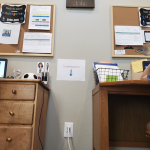“A lack of transparency results in distrust and a deep sense of insecurity.” – Dalai Lama
When schools began opening buildings for in-person learning a few months ago, assurances were given to staff members and families. Promises of safety protocols and mitigation strategies were declared at board meetings and in communications to families and staff. Among the COVID procedures were plans for transparency when positive cases occurred on a campus. Many districts published sample notification letters on their websites along with an explanation for when the letters would be used.
Now that we’ve moved from theory to practice, schools have had time to live the procedures. With this reality, has come growing concern among staff and parents that the transparency they anticipated is not living up to expectations.
Most people assumed when a confirmed COVID case occurred on a school campus, all stakeholders of that campus would be notified. After all, it’s not uncommon for entire grade levels to be notified of a case of head lice. Therefore, we would certainly expect to be notified of a confirmed case of a highly contagious virus that has caused a global pandemic.
Despite the very reasonable expectation of open and transparent notification, this is not what is happening in many districts. Some school organizations are being frustratingly tightlipped with their COVID communication and limiting their notifications to the smallest of possible circles.
This secrecy creates an abundance of problems that will have short term and long lasting effects. The lack of transparency creates distrust among staff and families, impedes comprehensive decision-making, and is bad for public health.
Trust
A school functions best when there is a positive and healthy school culture. Trust is the foundation of a successful school climate. Open and transparent communication builds trust. It is vital for a school’s staff and community members to trust in the comprehensiveness and accuracy of the information they are given. Conversely, a practice of ambiguous or secretive communication breeds distrust. If a district is perceived as withholding COVID data, stakeholders are left to wonder what other information might be withheld.
A lack of trust impacts a district from multiple fronts. Arizona’s public schools, suffering a terrible teacher shortage, have had this problem exacerbated during COVID. Staff retention should be the top priority for school districts considering there are very few qualified educators willing to fill vacant teaching positions. Yet, a lack of transparency will have the exact opposite impact on retention. As noted by a community member in a local online discussion, “Teachers need to take note of how districts treated their employees during this time and make smart decisions when those contracts come out.” This sentiment was echoed in a survey I recently circulated. More than one in five teachers who responded said that the lack of transparency in their district was causing them stress that had them considering leaving their district.
In addition to the impacts on staff, the lack of transparency may also have an impact on parents’ attitudes toward their children’s districts. In Arizona, where school choice is coveted, districts typically try to avoid decisions that would cause families to choose enrollment in another district. Districts that are less than completely transparent with COVID cases may lose the trust of their families and therefore see those families leave for other schools.
Decision-making
Parents are making very difficult choices about their child’s education this school year. Whether or not to send a child to in-person school or remain online is a decision that requires all information be made available. In order to make those decisions, parents are relying on the integrity of the school districts to provide them with information about not just mitigation efforts, but also the number of COVID cases in their child’s school. The number of COVID cases on a campus is data that would factor into a parent’s decision-making process.
Some districts have effective notification policies in place that quickly disseminate the information to all families and staff members. The communication protocol includes immediately notifying the entire school community of the most recent date the COVID positive person was on campus. Indirect contacts are then notified. Lastly, direct contacts are notified and required to quarantine.
This level of transparency should be used by all school districts. Parents deserve to have transparency with COVID data when making a decision about learning models for their children.
Public Health
A lack of transparency with COVID positive cases in schools is bad for public health. It has been widely communicated by infectious disease experts that one of the best methods for managing COVID is to have frequent, fast testing and robust contact tracing. This allows for those who test positive to immediately isolate. Further, casting a wide net in contact tracing enables all potential contacts to be tested, monitor symptoms, and quarantine if necessary.
When a school notifies all of its staff and families about a COVID positive case, it allows the process of voluntary testing and isolation to begin quickly. Being transparent with the entire school community is good public health policy that will help contain the spread of COVID. This will allow schools to safely remain open for in-person learning. Districts who choose to minimize the amount of people they notify are not only harming public health, but also reducing the likelihood of safely continuing in-person school.
In the current situation we are all living through, we need more transparency rather than less.
In the comments of a local newspaper story, I recently came across a heated discussion among parents about the lack of transparency in a district. The last comment in the conversation was, “Best believe, there is a lack of transparency and honesty.” I know this isn’t the message districts want to convey. I hope those who are choosing to limit their COVID communication change direction and select a more transparent path. The trust and security of their community depend on it.










Comments 6
I completely agree that the lack of transparency makes it difficult for parents to make informed decisions for their child’s education. I feel fortunate that my district is very transparent but due to that transparency our cases will make the news, while districts or charters that aren’t as transparent look like they have no cases/no problems.
Author
Maria, you are exactly right. Districts that are not being transparent still have COVID cases, parents and the community just don’t know about them. I applaud your district for their transparency. It will pay off in the long run.
Nicole, this is such an important topic and I’m so glad to read your discussion of it. As you described, a lack of communication results in lack of trust. The negative impact on staff and the community when trust is damaged cannot be overstated. Thank you for so eloquently raising awareness of the need for transparency.
Author
Thank you. I’m truly concerned about the distrust that is being created by these decisions and the impact it will have.
Nicely written Nicole. I wish every district everywhere would be totally transparent. Our numbers are just going through the roof and it’s sad. It does not have to be this way.
I found out this week (after a email notification of a case in my building) that our contact tracing is a Google Form you fill out when you’re sick… It doesn’t exactly instill confidence that I would be notified of an exposure if we have to trust people to fill out an extremely long and confusing Google Form while experiencing COVID symptoms.